

Ziring Book Pages - 3rd Quarter '96 Reviews
These are the reviews from the summer of 1996. For
newer reviews, go back to the
main book page.
 Brightness
Reef by David Brin - 1995, Bantam Books (ISBN 0-553-10034-3)
Brightness
Reef by David Brin - 1995, Bantam Books (ISBN 0-553-10034-3) - This science fiction novel is the first of a new trilogy from the well-respected
author David Brin. It is set in the universe established by Sundiver
and Startide Rising, but in a new setting and with new and fascinating
characters. The plot is complex, and the pace is leisurely (for the most
part); the reader has plenty of time to enjoy the development of the story
and get to know the characters. Beware - like other leading books of trilogies,
Brightness Reef leaves many unresolved points, leaving the reader
anxious to learn the fates of the characters and their world. If the rest
of the trilogy is as good as the first book, though, it will be worth the
wait.
Conclusion: Highly Recommended, a must for Brin fans
- --------------------------------------
- Legacy by Greg Bear - 1995, Tor Books (ISBN
0-312-85516-8)
- Greg Bear grabbed the attention of the Sci-Fi community with his book
Eon. This new novel is set in the same universe (sort of), and deals
with an early period in the life of one of Eon's most enigmatic characters.
The author paints a vivid and engaging portrait of Lamarkia, a world which
seems poised on the brink of several different disasters. The reader follows
the hero through a variety of adventures, and through a deep process of
self-discovery. There are also some moral messages to be drawn from
the events and the characters' reactions to them. Legacy is a very
good book, but in the shadow of a towering novel like Eon, it really
serves as not much more than a lengthy prelude.
Conclusion: Read Eon first, then read Legacy.
- -----------------------------------
- Alice In Quantumland by Robert
Gilmore - 1995, Springer-Verlag (ISBN 0-387-91495-1)
 This
short book is subtitled "An Allegory of Quantum Physics." It
recounts the adventures of a rather modernized Alice as she wanders through
various microscopic realms, and meets idiosyncratic characters. The book
is filled with charming line drawings vaguely remeniscent of those that
have graced numerous editions of Lewis Carroll's classic. The physics is
presented in a light-hearted and simplified way, but the book is never
condescending. In areas where a detailed or technical explanation can be
helpful, one is given in a separate box. The mathematics underlying the
physics is not presented in any fashion, which is the only sane choice
for the average reader when one considers the kind of mathematics needed.
Dr. Gilmore, a physicist from Bristol, UK, manages to cover a lot of ground
in only 180 pages. Unfortunately, while the book is interesting and amusing,
it does not quite serve to introduce an uninformed reader to the oddities
and importance of quantum physics.
This
short book is subtitled "An Allegory of Quantum Physics." It
recounts the adventures of a rather modernized Alice as she wanders through
various microscopic realms, and meets idiosyncratic characters. The book
is filled with charming line drawings vaguely remeniscent of those that
have graced numerous editions of Lewis Carroll's classic. The physics is
presented in a light-hearted and simplified way, but the book is never
condescending. In areas where a detailed or technical explanation can be
helpful, one is given in a separate box. The mathematics underlying the
physics is not presented in any fashion, which is the only sane choice
for the average reader when one considers the kind of mathematics needed.
Dr. Gilmore, a physicist from Bristol, UK, manages to cover a lot of ground
in only 180 pages. Unfortunately, while the book is interesting and amusing,
it does not quite serve to introduce an uninformed reader to the oddities
and importance of quantum physics.
Conclusion: Recommended, best for readers already familiar with quantum
physical concepts - --------------------------------------
- The Diamond Age by Neal Stephenson
- 1995, Bantam Books (ISBN 0-553-57331-4)
- This science fiction novel relates the complicated tale of Nell, a
child growing up in an age of explosive potential. The narrative is centered
on Nell, but also delves deep into the characters of several persons who
help make her who she becomes. The "Diamond Age" is a time in
the near future when nanotechnology has changed how human business and
social life are conducted, and is poised to change things much further.
The subtitle of the book, "or, A Young Lady's Illustrated Primer"
refers to a marvelous book that Nell is given. The story of the real Nell
growing up in urban environment around the China Sea, and the storybook
Nell growing up in the Primer, are wonderfully intertwined. The other characters
that populate the book are colorful and engaging, if sometimes a little
extreme, and they flesh out the moral themes of the book quite well. Neal
Stephenson's previous book, Snow Crash, painted an gritty and thought-provoking
portrait of the near future. The Diamond Age reaches a little further
off in time, and in a different direction, but shares the fine detail and
depth that made its predecessor so enjoyable.
Conclusion: Highly recommended
- --------------------------------------
- Reptiles and Amphibians
Dr. H. Cogger & Dr. R. Zweifel, editors - 1992, Smithmark Publishers
(ISBN 0-8317-2786-1)
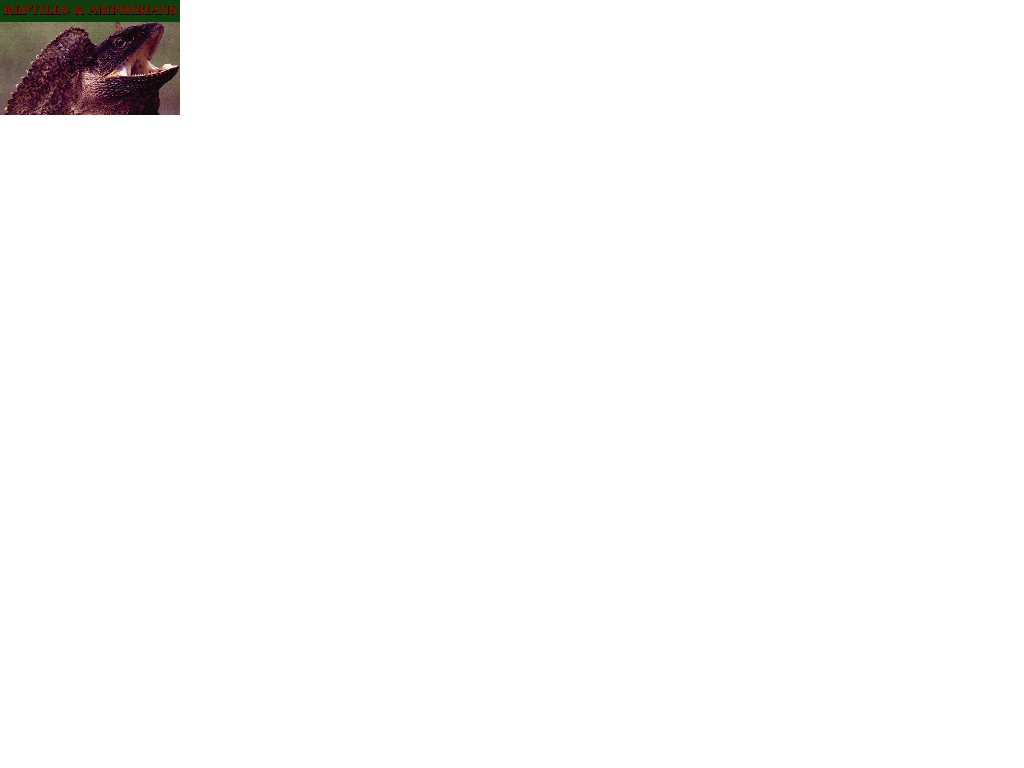 This
beautiful but expensive book defies easy categorization. In format and
appearance, it is a coffee-table book about cold-blooded critters, full
of eye-catching photographs and diagrams. Its content, however, is detailed
and authoritative enough to make it interesting and rewarding for any amateur
herpetologist. After the introductory material, the book is divided ridgedly
into sections based on the different taxonomic groups of class REPTILIA
and AMPHIBIA. Each section is written by a different university professor
or museum director. The only disappointment, if it is one, is that the
photographs seem to have been selected more for their drama and composition
than for the instructive value. The quality of the printing and typography
is uniformly good, better than stereotypical coffee-table fare. Also noteworthy
is the book's comprehensive index, a boon for looking up a particular reptile
or amphibian when all you know is its common name and not its scientific
name.
This
beautiful but expensive book defies easy categorization. In format and
appearance, it is a coffee-table book about cold-blooded critters, full
of eye-catching photographs and diagrams. Its content, however, is detailed
and authoritative enough to make it interesting and rewarding for any amateur
herpetologist. After the introductory material, the book is divided ridgedly
into sections based on the different taxonomic groups of class REPTILIA
and AMPHIBIA. Each section is written by a different university professor
or museum director. The only disappointment, if it is one, is that the
photographs seem to have been selected more for their drama and composition
than for the instructive value. The quality of the printing and typography
is uniformly good, better than stereotypical coffee-table fare. Also noteworthy
is the book's comprehensive index, a boon for looking up a particular reptile
or amphibian when all you know is its common name and not its scientific
name.
Conclusion: Pricey, but well worth it for animal enthusiasts - --------------------------------------
- RING Stephen Baxter - 1994, Harper Collins
(ISBN 0-06-105694-4)
- Baxter has earned a solid reputation as an author of "hard"
science fiction, the kind that utilizes wild but legitimate scientific
ideas as the basis for storyline. RING fits this genre very well. The story
includes universe-spanning themes and conflict, dealt with by a small cast
of detailed characters. It is these characters, more than the action or
plot, that hold back what could have been a great SF novel. RING
is set in a self-consistent future history that Baxter has used in several
of his published works: novels Timelike Infinity, Flux, and
(somewhat) Raft, as well as short stories. This book is meant to
tie all those other works together, and it does so pretty well, but this
story and its characters doesn't have the same punch as some of its precessors.
Conclusion: Not recommended.
(Buy the author's 1993 book FLUX instead, ISBN 0-06-100837-0)
- --------------------------------------
- The Java Programming Language Ken Arnold
and James Gosling - 1996, Addison Wesley (ISBN 0-201-63455-4)

- This is the definitive book on the Java language itself, written by
two very well-known computer programming authors, one of whom was a chief
architect of the language. The book is extremely well organized, and provides
in-depth information about Java's syntax and semantics. It is set up to
be used both as an authoritative description and as a learning aid -- each
section contains programming exercises for students. This book is not
designed to assist the impatient web author eager to write spiffy applets
for their web pages. It offers no coverage of the runtime APIs used for
applets and graphics. The intended audience of this book is serious programmers
who need to know how the language really works, and why.
Conclusion: Recommended, for serious students of programming
- ---------------------------------------
- The Ringworld Throne Larry Niven - 1996,
Ballantine Books (ISBN 0-345-35861-9)
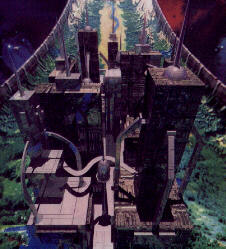 Larry Niven is
a well-known name in science fiction, and this new novel really shows his
consummate writing style and knack for ideas. It is the third novel set
on the Ringworld,
a ring-shaped artifact so large it completely encircles its sun. The first
novel, simply named Ringworld (1970), is considered one of the best
(if not the best) hard science fiction novel ever written. The second book,
Ringworld Engineers (1980), was also extremely good. Ringworld Throne
finds the main character from the first two books, Louis Wu, still on the
ringworld and caught up in an incipient power struggle. There is also a
fascinating sub-plot that evolves around a former associate of Louis's
that provides some of the excellent exploration of the relationships between
the different subspecies that inhabit the ringworld's huge expanses. The
action and ideas accelerate as the book continues, until, near the end,
the paragraphs get dense enough to require several reading to glean all
their implications.
Larry Niven is
a well-known name in science fiction, and this new novel really shows his
consummate writing style and knack for ideas. It is the third novel set
on the Ringworld,
a ring-shaped artifact so large it completely encircles its sun. The first
novel, simply named Ringworld (1970), is considered one of the best
(if not the best) hard science fiction novel ever written. The second book,
Ringworld Engineers (1980), was also extremely good. Ringworld Throne
finds the main character from the first two books, Louis Wu, still on the
ringworld and caught up in an incipient power struggle. There is also a
fascinating sub-plot that evolves around a former associate of Louis's
that provides some of the excellent exploration of the relationships between
the different subspecies that inhabit the ringworld's huge expanses. The
action and ideas accelerate as the book continues, until, near the end,
the paragraphs get dense enough to require several reading to glean all
their implications.- In general, this is a fine book and well worth reading. Is it another
mind-boggling classic like the original Ringworld? Sadly, no, but the story
and characters are so involving that you won't really mind. Note, however,
that the story pretty much assumes you've read at least one of its two
predecessors.
- Conclusions: Recommended, a must for science fiction fans.
[Ziring
MicroWeb Home] [Neal
Ziring] [Julie
Ziring] [EROLS Internet]
This page written by Neal
Ziring, last modified 9/30/96.


 Brightness
Reef by David Brin - 1995, Bantam Books (ISBN 0-553-10034-3)
Brightness
Reef by David Brin - 1995, Bantam Books (ISBN 0-553-10034-3)  This
short book is subtitled "An Allegory of Quantum Physics." It
recounts the adventures of a rather modernized Alice as she wanders through
various microscopic realms, and meets idiosyncratic characters. The book
is filled with charming line drawings vaguely remeniscent of those that
have graced numerous editions of Lewis Carroll's classic. The physics is
presented in a light-hearted and simplified way, but the book is never
condescending. In areas where a detailed or technical explanation can be
helpful, one is given in a separate box. The mathematics underlying the
physics is not presented in any fashion, which is the only sane choice
for the average reader when one considers the kind of mathematics needed.
Dr. Gilmore, a physicist from Bristol, UK, manages to cover a lot of ground
in only 180 pages. Unfortunately, while the book is interesting and amusing,
it does not quite serve to introduce an uninformed reader to the oddities
and importance of quantum physics.
This
short book is subtitled "An Allegory of Quantum Physics." It
recounts the adventures of a rather modernized Alice as she wanders through
various microscopic realms, and meets idiosyncratic characters. The book
is filled with charming line drawings vaguely remeniscent of those that
have graced numerous editions of Lewis Carroll's classic. The physics is
presented in a light-hearted and simplified way, but the book is never
condescending. In areas where a detailed or technical explanation can be
helpful, one is given in a separate box. The mathematics underlying the
physics is not presented in any fashion, which is the only sane choice
for the average reader when one considers the kind of mathematics needed.
Dr. Gilmore, a physicist from Bristol, UK, manages to cover a lot of ground
in only 180 pages. Unfortunately, while the book is interesting and amusing,
it does not quite serve to introduce an uninformed reader to the oddities
and importance of quantum physics. 
 This
beautiful but expensive book defies easy categorization. In format and
appearance, it is a coffee-table book about cold-blooded critters, full
of eye-catching photographs and diagrams. Its content, however, is detailed
and authoritative enough to make it interesting and rewarding for any amateur
herpetologist. After the introductory material, the book is divided ridgedly
into sections based on the different taxonomic groups of class REPTILIA
and AMPHIBIA. Each section is written by a different university professor
or museum director. The only disappointment, if it is one, is that the
photographs seem to have been selected more for their drama and composition
than for the instructive value. The quality of the printing and typography
is uniformly good, better than stereotypical coffee-table fare. Also noteworthy
is the book's comprehensive index, a boon for looking up a particular reptile
or amphibian when all you know is its common name and not its scientific
name.
This
beautiful but expensive book defies easy categorization. In format and
appearance, it is a coffee-table book about cold-blooded critters, full
of eye-catching photographs and diagrams. Its content, however, is detailed
and authoritative enough to make it interesting and rewarding for any amateur
herpetologist. After the introductory material, the book is divided ridgedly
into sections based on the different taxonomic groups of class REPTILIA
and AMPHIBIA. Each section is written by a different university professor
or museum director. The only disappointment, if it is one, is that the
photographs seem to have been selected more for their drama and composition
than for the instructive value. The quality of the printing and typography
is uniformly good, better than stereotypical coffee-table fare. Also noteworthy
is the book's comprehensive index, a boon for looking up a particular reptile
or amphibian when all you know is its common name and not its scientific
name. 
 Larry Niven is
a well-known name in science fiction, and this new novel really shows his
consummate writing style and knack for ideas. It is the third novel set
on the Ringworld,
a ring-shaped artifact so large it completely encircles its sun. The first
novel, simply named Ringworld (1970), is considered one of the best
(if not the best) hard science fiction novel ever written. The second book,
Ringworld Engineers (1980), was also extremely good. Ringworld Throne
finds the main character from the first two books, Louis Wu, still on the
ringworld and caught up in an incipient power struggle. There is also a
fascinating sub-plot that evolves around a former associate of Louis's
that provides some of the excellent exploration of the relationships between
the different subspecies that inhabit the ringworld's huge expanses. The
action and ideas accelerate as the book continues, until, near the end,
the paragraphs get dense enough to require several reading to glean all
their implications.
Larry Niven is
a well-known name in science fiction, and this new novel really shows his
consummate writing style and knack for ideas. It is the third novel set
on the Ringworld,
a ring-shaped artifact so large it completely encircles its sun. The first
novel, simply named Ringworld (1970), is considered one of the best
(if not the best) hard science fiction novel ever written. The second book,
Ringworld Engineers (1980), was also extremely good. Ringworld Throne
finds the main character from the first two books, Louis Wu, still on the
ringworld and caught up in an incipient power struggle. There is also a
fascinating sub-plot that evolves around a former associate of Louis's
that provides some of the excellent exploration of the relationships between
the different subspecies that inhabit the ringworld's huge expanses. The
action and ideas accelerate as the book continues, until, near the end,
the paragraphs get dense enough to require several reading to glean all
their implications.